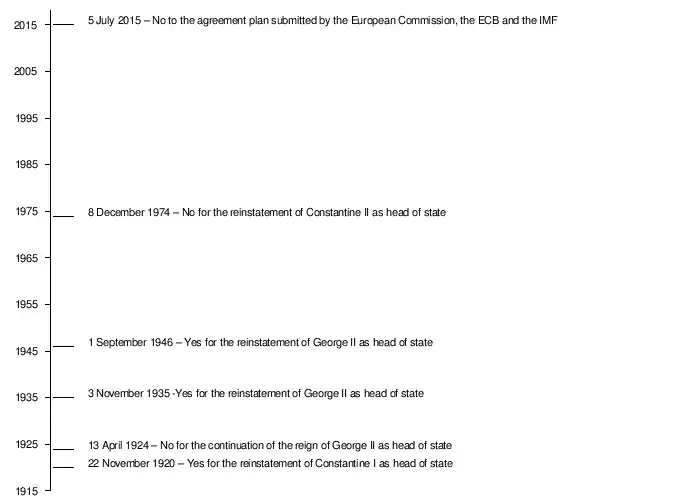Elections in Greece
Elections in Greece gives information on elections and election results in Greece.
| This article is part of a series on |
| Politics of Greece |
|---|
 |
|
|
Election of the legislature
The Greek Parliament (Voulí ton Ellínon) has 300 members, elected for a four-year term by a system of 'reinforced' proportional representation in 59 constituencies, 52 of which are multi-seat and 7 single-seat. Seats are determined by constituency voting, and voters may select the candidate or candidates of their choice by marking their name on the party ballot. However, the party receiving the largest number of votes receives a 50-seat premium, which is filled by candidates of that party not declared elected on the lower rungs (the constituencies).
Greek citizens aged 17 and over on the year of the election are eligible to vote, and at the age of 25 and over are also eligible to be elected to Parliament. Women's suffrage was adopted in 1930.
Constituencies
_by_number_of_seats.svg.png.webp)
Constituencies in Greece have traditionally been multi-seat, and they mostly coincide with prefectures. The number of seats is adjusted once every ten years, following the decennial population census. Prefecture constituencies may not be deprived of representation, nor may they be merged with another prefecture; they may however be split into smaller constituencies if their population increases disproportionately: nevertheless this has not been done since 1967. Population changes have left eight (Kefalonia, Lefkas, Eurytania, Grevena, Samos, Thesprotia, Phocis and Zakynthos) prefectures with a single parliamentary seat each, whereas some urban or suburban constituencies have seen large increases in their seat allotment over the years.
For example, the "Athens B" constituency (which includes the major part of the Athens metropolitan area but excludes the Municipality of Athens itself, which forms the "Athens A" constituency) encompasses almost 15% of the country's electorate and consequently elects 42 members of parliament. The "Athens A" constituency elects 17 MPs, "Thessaloniki A" elects 16, Attica (excluding the four Athens and Piraeus A and B constituencies) elects 12, and the remaining constituencies elect single-digit numbers of MPs.
Voting
Polling takes place in school buildings on a Sunday, a festive occasion for students who are then given a four-day weekend off. The procedure is run by a presiding judge or attorney-at-law appointed by the local Bar association, and secretarially assisted by local citizens selected by lot in a process resembling jury duty. Local police are available too. Local party representatives are allowed to monitor tallying; their theoretical role is to ensure transparency.
Traditionally, voting takes place "from sunrise to sunset" but times are usually rounded to the nearest "top of the hour" (e.g., 7 am to 8 pm). Individual precincts may prolong voting time at the judge's discretion, if there are still voters queueing up to vote. Voters identify themselves by their ID cards and are given the full number of ballot papers for the constituency plus a blank ballot paper and an empty envelope. Then they withdraw to a secluded cubicle equipped with a lectern, pen and waste basket, where they select the ballot paper of their choice, if any, and mark the candidate(s) of their choice, if any; they cast the sealed envelope with the ballot paper in the ballot box and are given their ID card back.
Voters may select specific candidates within the party list of their choice by marking a cross next to the candidate name or names. The maximum allowable number of crosses on the ballot paper depends on the number of seats contested. Signs other than crosses next to a candidate name may mark the ballot as invalid during tallying, as such findings may be construed to violate voting secrecy. Ballot papers with more crosses than the maximum number allowed, or without any cross, are counted in the total party tally but are disqualified during the second part of tallying, i.e. the determination of which individual candidate is elected to a seat already won by the candidate's party.
Once on-the-spot tallying is over and the tallies reported officially, the ballots are sealed and transported to the Central Election Service of the Interior Ministry. There ballots are recounted, mainly to ascertain the validity or invalidity of the few ambiguously marked ballot papers. Any unresolved matters following this recount are referred to the specially convened Eklogodikeion (Court of Election), which adjudicates and then officially publishes the names of elected MPs, so that the new Parliament may convene. The Court of Election may reconvene at any time to discuss appeals by candidates who failed to be elected, and also to fill seats that become vacant in the case of death or abdication of an MP. Such seats are filled by going down the preference tally of the party list that won the seat in the first place (there are no by-elections in Greece unless a party list is exhausted: an extremely rare occurrence).
Greek citizens permanently living in European Union countries are allowed to vote in European Parliament elections; nevertheless very few of them actually vote as they have to do so in person at their local Greek embassy or consulate.
Electoral system
.svg.png.webp)
The Greek electoral system was codified for the first time by Presidential Decree in 2012;[1] prior to that date it was made up of various pieces of legislation passed at different times. The current system is called "reinforced proportionality" in Greece (ενισχυμένη αναλογική), and is a form of semi-proportional representation with a 50-seat majority bonus for the party that wins a plurality of the vote. There is also an electoral threshold of 3% which all parties and individuals need to pass on a national level before being awarded any seats. These provisions are aimed at helping the largest party secure an absolute majority of parliamentary seats (151 out of 300), enhancing governmental stability. The majority bonus of 50 seats was abolished in 2016,[2] but was still applied at the 2019 Greek legislative election because the new electoral law did not receive a supermajority in Parliament, and can thus not be enforced in the next election.
The next election will see the electoral system change to proportional representation, as the majority bonus will cease to be applied since it was abolished in 2016. The election after next will revert to semi-proportional representation with a sliding scale bonus after it was passed in parliament in 2020.[3][4]
The 50-seat majority bonus system was used for the first time in the May 2012 election; it reserves 50 parliamentary seats for the party emerges as the largest by total votes cast on a national level. The remaining 250 seats are divided proportionally in parliamentary constituencies according to each party's total valid vote percentage; this is slightly higher than the raw percentage reported, as there is always a small number of invalidated or "blank" votes (usually less than 1%), as well as the percentage of smaller parties that fail to surpass the 3% threshold, all of which are disregarded for the purpose of seat allotment. The previous law (used in the 2009 legislative elections) was less favorable for the plurality party, as only 40 additional seats were reserved for them.
Articles 99 and 100 of the codified electoral law lay out the way in which parties are allocated seats in accordance with the percentage of votes they received in a legislative election.[1] The introduction of the majority bonus makes seat allocation especially complex, but the steps followed for the allocation of seats are as follows:
- The number of seats a party is entitled to is first determined by dividing the total number of valid votes cast for parties which have surpassed the 3% national threshold and dividing it by 250 (99§2); this is later used to 'correct' the proportional results in the constituencies, ensuring that 50 seats always remain empty for the majority bonus.
- The 12 seats elected through national-wide party-list are awarded by first determining a quota by taking the total number of valid votes for parties which have surpassed the 3% electoral threshold on a national level and dividing it by 12 (100§1). The total number of valid votes cast for each party is then divided by the quota, and the sum is rounded down, disregarding decimals, to produce the number of seats the party is awarded (100§2), so that a sum of 5.6 for example awards 5 seats to that party. If any of the 12 seats left empty in this step, a seat is awarded to each party in descending order of leftover decimals until all seats have been allocated in this manner (100§3).
- The 7 seats elected through first-past-the-post in single-seat constituencies are awarded to the party which has the most votes in each of the constituencies in question, provided that that party has surpassed the 3% electoral threshold on a national level (100§5).
- The 231 seats elected proportionally in constituencies are awarded by first determining a quota by taking the total number of valid votes cast for all parties in the constituency, regardless of if they have surpassed the 3% electoral threshold on a national level, and dividing it by the total number of seats in the constituency (100§4). The total number of valid votes cast for each party is then divided by the quota, and the rounded down sum corresponds to the number of seats each party is awarded in that constituency (100§4), so that again a sum of 5.6 would be awarded 5 seats. Any party which is entitled to more seats than it had candidates on the ballot paper can only be awarded a number of seats equal to the number of candidates it fielded (100§5). Any leftover seats are then awarded by calculating the difference between the total number of seats a party has received on a national level so far and the seats a party is entitled to according to the first step (100§6). The same procedure is then followed on all constituencies except single-member ones (100§6), to determine which constituencies each party is over- or under-represented in. This sum is used to award one seat, in descending order of sums, to that party which has the highest leftover sum in each of the two-member and three-member constituencies until all seats have been awarded (100§7). If any party has been awarded more seats on a national level than it is entitled to, the extra seats are removed from three-member (or, if necessary, two-member) constituencies in which that party has the lowest leftover sums (100§7). If there are still empty seats, those constituencies are ranked in descending order by leftover sums of parties which have surpassed the 3% electoral threshold on a national level, and one seat is awarded in each constituency to the smallest party by total number of valid votes above the 3% threshold, until that party has been awarded the total number of seats it is entitled to according to the first step (100§8). If there are still seats available, the last step is followed again and seats awarded to each party in ascending order of valid votes received, until all seats have been awarded.
- The 50 seats of the majority bonus elected in constituencies are awarded after the above steps have been completed, ensuring that 50 seats remain available for the largest party (99§3a). A coalition can also be awarded the 50 seats provided that the average percentage of votes for each party in the coalition is larger than the percentage of votes received by the largest party on a national level, and in that case it is the Supreme Civil and Criminal Court of Greece that decides on whether a coalition qualifies for the allocation of the 50 seats (99§3b).
A rather complicated set of rules deals with rounding decimal results up or down, and ensures that the smaller a constituency is, the more strictly proportional its parliamentary representation will be. Another set of rules apportions the 50 seat premium for the largest-tallying party among constituencies. Individual seats are apportioned by "cross of preference". Voters mark a cross next to the name of the candidate or candidates they prefer, the number of crosses varying from one to five depending on constituency size. Ballots with no crosses or more crosses than allowed, count for only the party but not the individual candidates.
Tallying is done manually in the presence of representatives of all contesting parties. Party tallying, which is easier, is done first so that returns may be announced quickly. Individual candidate tallying is done next and can take several days. Once the number of seats per party and constituency is determined, the seats are filled on a top-down basis from the individual cross-of-preference tallies. Party heads and acting or past Prime Ministers are exempt from cross-of-preference voting: they are automatically placed at the top of their party list and are elected, provided their party achieves at least one seat in the particular constituency.
By constitutional provision, the electoral law can be changed by simple parliamentary majority, but a law so changed comes into effect in the next-but-one election, unless a two-thirds parliamentary supermajority (200 or more votes) is achieved. Only in the latter case is the new electoral law effective at the next election. A case in point is the current electoral law, which was passed in 2020. Because this law was passed by a simple majority, it will not used for the subsequent 2023 election, but can be used in the 2027 election.
| Law's "trademark" | Passed in | Passed by | Applied in (election year) | Approximate nationwide vote percentage needed for an absolute majority of seats in Parliament for the largest party | Threshold |
|---|---|---|---|---|---|
| Reinforced proportionality | 1974 | New Democracy | '74, '77, '81, '85 (the premium of seats was reduced) | in almost any case (40% and a clear advantage were necessary in '74 elections) | none for the first seat allocation (in prefectures), but 17% for the second one in peripheries (this threshold was not in force during '85 elections) |
| Simple proportionality | 1989 | Panhellenic Socialist Movement | '89 (Jun), '89 (Nov), '90 | 47%+ | none |
| Reinforced proportionality | 1990 | New Democracy | '93, '96, '00, '04 | in almost any case | 3% |
| 2004 | Panhellenic Socialist Movement | '07, '09 | 41.5%+ | ||
| 2008 | New Democracy | '12 (May), '12 (Jun), '15 (Jan), '15 (Sep), '19 | 39%+ | ||
| Simple proportionality | 2016 | Syriza | Elections after 2019 | 47%+ | |
| Reinforced proportionality | 2020 | New Democracy | Elections after 2019 | 39%+ |
Electorate
All Greek citizens aged 17 or over in the year of the election are eligible to vote, provided they are on the electoral register, unless:
- they are imprisoned for a criminal offence and they have been expressly deprived of the right to vote by judicial decision (this happens only in the rare cases of high treason or mutiny). Incarcerated persons vote in polling stations specially set up inside prisons
- they are mentally incapable of making a reasoned judgement, according to a judicial decision. In practice, this applies only to a percentage of institutionalised mental patients
In the past, citizens who reached adulthood had to register and were issued an "election booklet" with which they voted. Nowadays, registration for voters is not needed: it is done automatically as each citizen comes of age. Identity is proved by state-issued ID cards or passport. Special registration is necessary only for absentee voting, which is done at the place of a voter's temporary residence on election day. Many Greeks choose to retain their voting rights in their family's original home, sometimes by reason of tradition, sometimes by reason of patronage. The Constitution provides, following the amendment of 2001, for the right of Greek citizens living abroad to vote for the legislative elections and the law implementing this constitutional provision was passed in 2019.[5]
Compulsory voting is the law in Greece but is not enforced. In the past a citizen had to present an up-to-date election booklet to be issued a driver licence or a passport, or else justify why they did not vote (e.g. because of absence, infirmity, or advanced old age). Nowadays the civic duty of voting is still considered "mandatory" but there are no sanctions for failing to vote.
Turnout at national elections is low: a mere 56.6% at the 2015 election and 57.9% at the 2019 election.
Political culture
.svg.png.webp)
Before 1910, Greece lacked a coherent party system in accordance with the traits of the modern representative democracy. The political formations of the 19th century lacked a steady organizational structure and a clear ideological orientation. Sometimes, they constituted just the incoherent and ephemeral escort of a prominent politician.
The first Greek parties with an ideological background, conforming to the modern conception of a political party, appeared after 1910, when Eleftherios Venizelos rose to predominance in Greek political life and founded his Liberal Party. The liberal wave of Venizelism resulted soon in the reaction of the "old-system" political leaders, who formed the core of an opposing conservative movement, which used the monarchy as its main rallying banner. Thereby, the two biggest ideological movements, the republican centrist-liberal and the monarchist conservative, emerged and formed massive political organizations.
The centrist and the conservative parties bitterly confronted each other in the ensuing legislative elections for many decades, until metapolitefsi. After the metapolitefsi of 1974, the leftist-socialist movement supplanted the centrists and took the main part of their electorate. A smaller part of erstwhile centrists, along with most conservatives, affiliated themselves with the centre-right New Democracy party, which self-defined as a liberal party and drafted the republican Constitution of 1975.
Until recently, Greece has had a two-party system dominated by the liberal-conservative New Democracy (ND) and the center-left Panhellenic Socialist Movement (PASOK). Other parties won far fewer seats. Beginning in the May and June 2012 legislative elections, SYRIZA (the Coalition of the Radical Left) overtook PASOK as the main force of the left wing. After almost three years of opposition to the ND-PASOK coalition government, SYRIZA took the most votes in the January 2015 elections and formed government, while PASOK just barely crossed the threshold.
Currently, the left is represented in Parliament by the Communist Party of Greece (KKE), SYRIZA, and PASOK. At the center is Stavros Theodorakis' liberal party To Potami (The River). To the right of ND, the Independent Greeks and Golden Dawn have small Parliamentary groups.
| Parties | '74 | '77 | '81 | '85 | '89 | '89 | '90 | '93 | '96 | '00 | '04 | '07 | '09 | '11 | '12 | '13 | '14 | '15 | '15 | '19 |
|---|---|---|---|---|---|---|---|---|---|---|---|---|---|---|---|---|---|---|---|---|
| New Democracy (ND) | X | X | X | X | X | X | X | X | X | X | X | 'X | ||||||||
| Panhellenic Socialist Movement (PASOK) | X | X | X | X | X | X | X | X | X | X | X | |||||||||
| Communist Party of Greece (KKE) (as part of Synaspismos) | X | X | ||||||||||||||||||
| Synaspismos (SYN) / Coalition of the Radical Left (SYRIZA) | X | X | ||||||||||||||||||
| Popular Orthodox Rally (LAOS) | X | |||||||||||||||||||
| Democratic Left (Greece) (DIMAR) | X | |||||||||||||||||||
| Agreement for the New Greece (SNE) (as part of PASOK after 22 August 2014) | X | |||||||||||||||||||
| Independent Greeks (ANEL) | X | X | ||||||||||||||||||
| Ecologist Greens (OP) | X | X | ||||||||||||||||||
2019 election
 | ||||||
| Party | Votes | % | Seats | +/– | ||
|---|---|---|---|---|---|---|
| New Democracy | 2,251,426 | 39.85 | 158 | +83 | ||
| Syriza | 1,781,180 | 31.53 | 86 | −59 | ||
| Movement for Change | 457,527 | 8.10 | 22 | +5 | ||
| Communist Party of Greece | 299,595 | 5.30 | 15 | 0 | ||
| Greek Solution | 208,806 | 3.70 | 10 | New | ||
| MeRA25 | 194,233 | 3.44 | 9 | New | ||
| Golden Dawn | 165,711 | 2.93 | 0 | −18 | ||
| Course of Freedom | 82,673 | 1.46 | 0 | New | ||
| Union of Centrists | 70,161 | 1.24 | 0 | −9 | ||
| Recreate Greece | 41,647 | 0.74 | 0 | 0 | ||
| United Popular Front | 28,269 | 0.50 | 0 | 0 | ||
| Antarsya | 23,191 | 0.41 | 0 | 0 | ||
| Popular Unity | 15,930 | 0.28 | 0 | 0 | ||
| Greek Assembly | 14,173 | 0.25 | 0 | 0 | ||
| Communist Party of Greece (Marxist–Leninist) | 7,778 | 0.14 | 0 | 0 | ||
| Marxist–Leninist Communist Party of Greece | 2,791 | 0.05 | 0 | 0 | ||
| Workers Revolutionary Party | 1,993 | 0.04 | 0 | 0 | ||
| Organisation of Internationalist Communists of Greece | 1,675 | 0.03 | 0 | 0 | ||
| Syn...Fonia Politikon Kommaton | 96 | 0.00 | 0 | 0 | ||
| Independents | 472 | 0.01 | 0 | 0 | ||
| Invalid/blank votes | 120,172 | – | – | – | ||
| Total | 5,769,542 | 100 | 300 | 0 | ||
| Registered voters/turnout | 9,962,261 | 57.91 | – | – | ||
| Source: Ministry of the Interior | ||||||
Election of the president of the republic

The head of state – the President of the Hellenic Republic – is elected by Parliament for a five-year term, and a maximum of two terms in office. Eligible for President is any person who:
- has had Greek citizenship for at least five years,
- has a father or a mother of Greek origin,
- is 40 years old or more,
- is eligible to vote.
When a presidential term expires, Parliament votes to elect the new president. In the first two votes, a 2/3 majority (200 votes) is necessary. The third and final vote requires a 3/5 (180 votes) majority. If the third vote is fruitless, Parliament is dissolved and elections are proclaimed by the outgoing president within the next 30 days.
In the new Parliament, the election for president is repeated immediately with a 3/5 majority required for the initial vote, an absolute majority (151 votes) for the second one and a ballot between the two persons with the highest number of votes in the second election for the third and final one. The system is so designed as to promote consensus presidential candidates among the main political parties.
Elected presidents of the Third Hellenic Republic (1974–present)

European Parliament elections
Greece has had a delegation of Members of the European Parliament in the European Parliament since Greek accession to the EU in 1984. Originally, the Greek delegation numbered 25, but after 2004 that was reduced to 24 (due to the increase of the EU member countries). In 2009, it was further reduced to 22, and in 2014 to 21 MEPs.
Electoral system
In the European elections, the whole country forms a single constituency and an electoral threshold is set at 3% of the vote. Members of the government and elected members of the Hellenic Parliament may only stand for election after having resigned from office.
Until 2014, the MEPs were elected on the basis of a party-list proportional representation system. Starting with the 2014 European Parliament election, candidates are elected on the basis of individual preference votes with a maximum of four preferences per voter.[7]
Latest election
| Party | EU Party | EP Group | Vote | Seats | ||||
|---|---|---|---|---|---|---|---|---|
| Votes | % | ±pp | Elect. | +/- | ||||
| New Democracy (ND) | EPP | EPP | 1,873,080 | 33.12 | +10.40 | 8 | +3 | |
| Coalition of the Radical Left (SYRIZA) | PEL | GUE-NGL | 1,343,788 | 23.75 | −2.80 | 6 | ±0 | |
| Movement for Change (KINAL) | PES | S&D | 436,735 | 7.72 | −0.30 | 2 | ±0 | |
| Communist Party of Greece (KKE) | INITIATIVE | NI | 302,677 | 5.35 | −0.76 | 2 | ±0 | |
| Golden Dawn (XA) | NI | 275,822 | 4.87 | −4.51 | 2 | −1 | ||
| Greek Solution (EL) | ECR | ECR | 236,361 | 4.18 | New | 1 | New | |
| European Realistic Disobedience Front (DiEM25) | DiEM25 | 169,286 | 2.99 | New | 0 | New | ||
| Course of Freedom | PEL | GUE-NGL | 90,859 | 1.61 | New | 0 | New | |
| The River | RE | 86,003 | 1.52 | −5.09 | 0 | −2 | ||
| Union of Centrists (EK) | EDP | 82,072 | 1.45 | +0.81 | 0 | ±0 | ||
| Greece, the Other Way [el] | 70,286 | 1.24 | New | 0 | New | |||
| Popular Orthodox Rally-Patriotic Radical Union [el] | 69,524 | 1.23 | −1.46 | 0 | ±0 | |||
| Citizens | 51,406 | 0.91 | New | 0 | New | |||
| Ecologist Greens (OP) | Greens | Greens/EFA | 49,099 | 0.87 | New | 0 | New | |
| Independent Greeks (ANEL) | ECR | ECR | 45,149 | 0.80 | −2.66 | 0 | −1 | |
| Free Homeland [el] | 41,188 | 0.73 | New | 0 | New | |||
| Party of Friendship, Equality and Peace | 40,245 | 0.71 | −0.04 | 0 | ±0 | |||
| Recreate Greece | 39,119 | 0.69 | New | 0 | New | |||
| New Right | 37,512 | 0.66 | New | 0 | New | |||
| Front of the Greek Anticapitalist Left (ANTARSYA) | 36,327 | 0.64 | −0.08 | 0 | ±0 | |||
| Agricultural Animal Party Greece | 31,810 | 0.56 | −0.01 | 0 | ±0 | |||
| Popular Unity-Pirate Party of Greece (LAE) | 31,671 | 0.56 | New | 0 | New | |||
| Greeks' Assembly | 29,489 | 0.52 | New | 0 | New | |||
| Greens | 25,448 | 0.45 | −0.05 | 0 | ±0 | |||
| Union for the Defense of Labour and the Social State-Strong Greece | 22,349 | 0.40 | New | 0 | New | |||
| Youth Party | 18,508 | 0.33 | New | 0 | New | |||
| Democratic Responsibility [el] | PES | S&D | 18,171 | 0.32 | New | 0 | New | |
| New Greek Momentum [el] | 12,289 | 0.22 | New | 0 | New | |||
| Marxist–Leninist Communist Party of Greece (M-L KKE) | 12,268 | 0.22 | +0.03 | 0 | ±0 | |||
| Greek Ecologists | 11,535 | 0.20 | +0.10 | 0 | ±0 | |||
| National Front-Patriotic League-Lions' Movement | 10,797 | 0.19 | New | 0 | New | |||
| People's European Social Groups | 10,318 | 0.18 | New | 0 | New | |||
| Panhellenic Citizen Chariot | 9,934 | 0.18 | New | 0 | New | |||
| Greek Radicals | 9,264 | 0.16 | New | 0 | New | |||
| Rainbow | EFA | Greens/EFA | 6,413 | 0.11 | New | 0 | New | |
| Liberal Alliance | ALDE | RE | 6,193 | 0.11 | New | 0 | New | |
| Organisation of Internationalist Communists of Greece (OKDE) | 4,823 | 0.09 | +0.04 | 0 | ±0 | |||
| People's European Social Groups-Agrarian Party of Greece-Associations for Culture and Development | 3,134 | 0.06 | New | 0 | New | |||
| Kollatos − Independent Political Movement | 3,132 | 0.06 | −0.10 | 0 | ±0 | |||
| Greek Vision | 2,038 | 0.04 | New | 0 | New | |||
| Blank and invalid votes | ||||||||
| Total | 5,656,122 | 100.00 | 21 | ±0 | ||||
| Registered voters / Turnout | 10,074,898 | 58.69% tournout | ||||||
Local elections
Local administration in Greece recently underwent extensive reform in two phases: the first phase, implemented in 1997 and commonly called the "Kapodistrias Project", consolidated the country's numerous municipalities and communities down to approximately 1000. The second phase, initially called "Kapodistrias II" but eventually named the "Callicrates Project", was implemented in 2010; it further consolidated municipalities down to 370, and merged the country's 54 prefectures into 13 peripheries. The Callicratean municipalities were designed according to several guidelines; for example each island (except Crete) was formed into a single municipality, while the majority of small towns were incorporated so as to have an average municipal population of 25,000.
The first prefectural elections took place in 1994; previously, prefects were executive appointees. Municipal elections were held since the formation of the modern Greek state, in the early 19th century.
Local administrators elected in 2010, following the Callicrates reform, are to serve a "rump" 3.5-year term. Starting in 2014, peripheral and municipal elections are to be held every five years, concurrently with elections for the European Parliament. In all local elections, the winning candidacy list is guaranteed a minimum three-fifths majority in the respective councils.
Past local elections since 1974
- 1975 Greek local elections
- 1978 Greek local elections
- 1982 Greek local elections
- 1986 Greek local elections
- 1990 Greek local elections
- 1994 Greek local elections
- 1998 Greek local elections
- 2002 Greek local elections
- 2006 Greek local elections
- 2010 Greek local elections
- 2014 Greek local elections
- 2019 Greek local elections
Referendums
The current Constitution provides for two kinds of referendums:
- a referendum concerning a "passed law"
- a referendum concerning a matter of "national interest".
The latest referendum was indeed concerning a matter of "national interest", in contrast to all the previous ones that concerned the form of government, specifically regarding the Greek monarchy.
Previous referendums
There were 7 referendums in Greece from 1920 to 1974. All but one had to do with the form of government, namely retention/reestablishment or abolition of the monarchy. The 1974 referendum resulted in confirming of the parliamentary republic. The only referendum not concerning only the form of government was the constitutional referendum in 1968 held by the military junta. There were no referendums in Greece between 1974 and 2014. In 2015, the Greeks voted no on the bailout proposed by the ECB and IMF, which was however rejected by the government.[9]




See also
References
- Εφημερίδα της Κυβερνήσεως τη Ελληνικής Δημοκρατίας [Government Gazette of the Hellenic Republic] (in Greek), A, Athens: National Publishing House, 15 March 2012, retrieved 11 March 2019
- Εφημερίδα της Κυβερνήσεως τη Ελληνικής Δημοκρατίας [Government Gazette of the Hellenic Republic] (in Greek), A, Athens: National Publishing House, 31 December 2018, retrieved 12 February 2019
- "Parliament votes to change election law | Kathimerini". www.ekathimerini.com. Retrieved 25 January 2020.
- Kampouris, Nick. "Greek Parliament Mulls Scrapping Proportional Representation | GreekReporter.com". Retrieved 25 January 2020.
- Kampouris, Nick. "Greek Parliament Approves Diaspora Vote Bill by Overwhelming Majority | GreekReporter.com". Retrieved 25 January 2020.
- Parliament Speaker Ioannis Alevras was acting President from 10 to 30 March 1985.
- Filippa Chatzistavrou; Sofia Michalaki (May 2014). "Fragmented and Polarised: Greece Ahead of European Elections 2014". In Sonia Piedrafita; Anne Lauenroth (eds.). Between Apathy and Anger: Challenges to the Union from the 2014 Elections to the EP in Member States (PDF). EPIN Paper. 39. EPIN. p. 45. Archived (PDF) from the original on 2 April 2015.
- "European parliament election – May 2019". ekloges.ypes.gr. Retrieved 28 May 2019.
- Kottasova, Mark Thompson and Ivana. "No! Greek vote shocks Europe". cnn.com. Archived from the original on 24 February 2018. Retrieved 5 May 2018.
Further reading
- Lyrintzis, Christos (March 2005). "The Changing Party System: Stable Democracy, Contested 'Modernisation'". West European Politics. 28 (2): 242–259. doi:10.1080/01402380500058845.
- Nicolacopoulos, Ilias (March 2005). "Elections and Voters, 1974–2004: Old Cleavages and New Issues". West European Politics. 28 (2): 260–278. doi:10.1080/01402380500058886.
External links
- Parties and elections
- Greek constituencies
- NSD: European Election Database – Greece publishes regional level election data; allows for comparisons of election results, 1990–2009